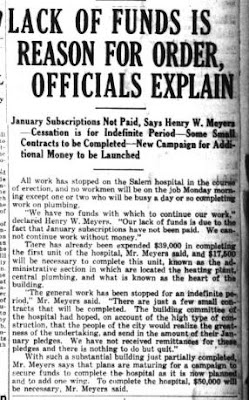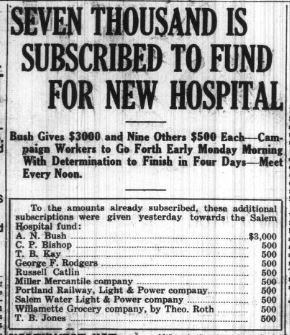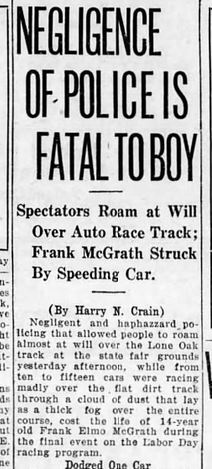The public hoopla for Labor Day in 1923 didn't have much to do with Labor. It was instead all about Capital. Tragedy abroad in a catastrophic earthquake in Japan, as well as tragedy at the race course, also distracted from attention to Labor.
 |
| September 2nd, 1923 |
The hoopla was about raising Capital to finish the new hospital, what became known as Salem General Hospital, just north of the State Hospital.
 |
| September 2nd, 1923 |
The Mayor proclaimed
One of the committees of the Salem hospital drive is promoting some automobile races to be held at the State Fair Grounds on Monday, September the 3rd, Labor Day. I respectfully urge as many citizens as possible to attend these races as the profits realized therefrom will complete the amount required to finish the hospital and no further drive for funds will be necessary.
 |
| Salem General Hospital, c.1930 (State Archives) |
Starting in late 1921 construction had been a very start-stop, stuttering affair. You may recall debate over prevailing wages in 1921. Once they settled that they laid the cornerstone. And then had to stop.
 |
| November 1st, 1921 |
 |
| February 5th, 1922 |
 |
| February 7th, and April 3rd, 1923 |
Over the summer in 1923 a major campaign attempted to close the funding gap. They made progress, but it wasn't quite enough.
 |
| July 15th, 1923 |
A race was the solution!
The Governor wanted to make a link to Labor Day.
 |
| September 3rd, 1923 |
Before the talk was actually given, in order to meet deadline, the afternoon paper reported he said
We are here to observe and to appreciate the spirit of young America, exemplified by the daring and thrilling races...When man came out of the wilderness, his sports were cruel. Death and bloodshed were required to amuse....He was setting up a contrast with modern sport, which did not require "death and bloodshed."
He would have spoken too soon.
It turned out he did not make it to the fair in time. The morning paper gave the prepared remarks in full.
 |
| September 4th, 1923 |
He said
It is proper, indeed, to give prominence to the automobile races today. The genius of man never game to humanity anything that exceeds the automobile in its influence...We are too close to the coming of the the automobile to realize its tremendous revolutionary effect upon our lives....The worker is no longer a slave but enjoys freedom and liberty...[and] is properly celebrated on this holiday by witnessing a contest for speed by automobiles — one of the great achievements of genius and labor.By this time tragedy had struck.
On the front page of the same edition, the paper said "Death rode in the Labor day automobile races at the Lone Oak race course at the State fair grounds yesterday." A boy of 14 apparently tried to cross the track while a race was still in session. There were also collisions that injured adult race drivers.
 |
| September 4th, 1923 |
The afternoon paper blamed policing and poor crowd control.
 |
| September 4th, 1923 |
It is hard to say what exactly was going on. People unaccustomed to higher auto speeds, or even rural residents for whom cars themselves were still a novelty, might not have been able to judge racing car speed. A few days earlier in August a person was fined in Salem for going 40mph on the way home from an event in Turner. Speeding in the city core was defined at even lower speed limits. Very few would be exposed to, and be able to judge, speeds more than 30 or 40mph. Just judging 30mph would be difficult for many still. Kids might have also been engaging in daredevil kinds of activity on the track. A need for more stringent crowd control at car races might not yet have been standard.
As for Labor, the morning paper didn't editorialize on it, but the afternoon paper did. Its sympathy was not much with Labor. Any "discontent of labor" was "largely the product of political agitation" and ultimately unwarranted.
 |
| September 3rd, 1923 |
All the way around, in 1923 celebrating and sympathizing with Labor in Labor Day was not stressed.


No comments:
Post a Comment